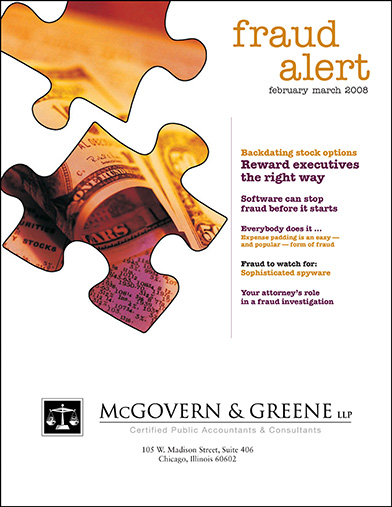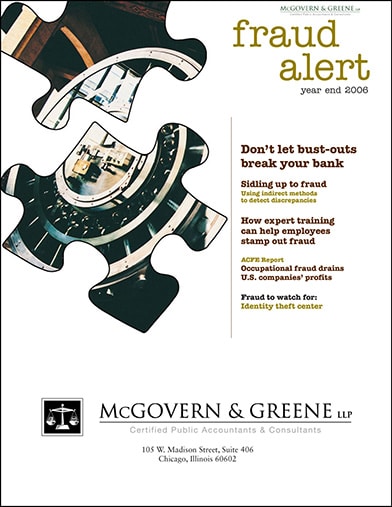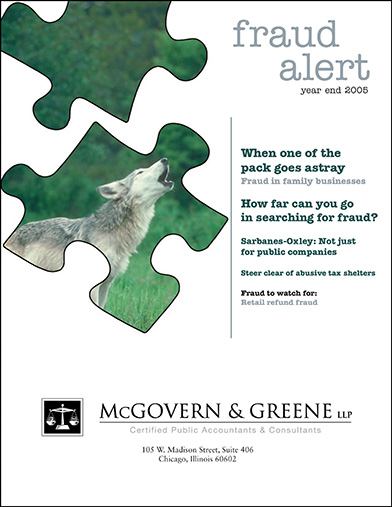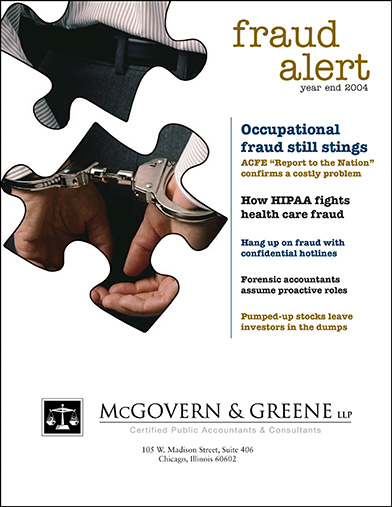Fraud Alert Magazine
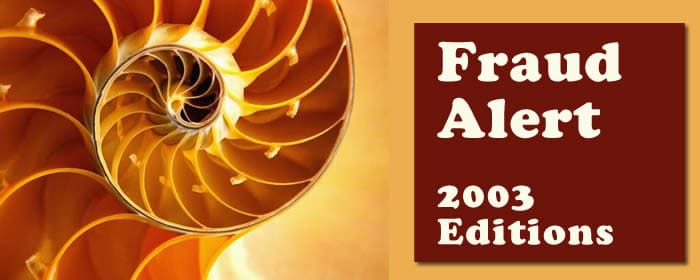
 YEAR END 2003 Issue of Fraud Alert
YEAR END 2003 Issue of Fraud Alert
Fair and square
Calculating fraud damage awards
It’s a widespread misconception that working out fraud damages is just a matter of “common sense.” In fact, satisfying the court as to damages’ fairness can involve complicated research and calculations, necessitating the help of a forensic accountant. The article tells how the expert decides, based on the type of transaction, what kind of damages the client can reasonably expect, then evaluates all other transactions that suffered because of the fraud and chooses the best method to calculate lost profits.
When divorce looms, shared funds can disappear
With a divorce in the offing, some spouses go out of their way to hide or undervalue marital assets to keep the other spouse from receiving a legitimate share of the money and property they acquired during the marriage. When it’s necessary to fend off fraud, many attorneys retain forensic accountants to trace funds, evaluate the spouses’ financial reports, value their businesses and investments and testify in court. The article explains some of the challenges facing forensic accountants in divorce cases and how they stop unscrupulous spouses from hiding joint funds.
Who’s reading your clients’ e-mail?
Quite a few people besides the intended recipients can read e-mail messages — even long after they’re deleted. The dangers of tampering with e-mail and impersonating an e-mail sender also are real, now that electronic signatures can be considered legally valid. This article offers crucial steps e-mail users can take to safeguard privacy and ensure authenticity. They include using encryption software, purchasing digital certificates, regularly purging archives and creating audit trails for important communications.
Fraud to watch for: Spotting fake checks and credit cards
Retailers and business owners should stay on the alert for phony checks and credit cards, a chronic problem nationwide. The No. 1 preventive measure is simple: Pay attention. Some fake credit cards and checks are laughably obvious, but nobody’s laughing because recipients are accepting them without a second glance. The article gives several examples of falsification methods, along with tips for exercising due diligence.
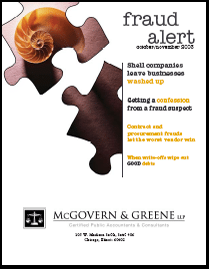 Fraud Alert OCT/NOV 2003 Issue of Fraud Alert
Fraud Alert OCT/NOV 2003 Issue of Fraud Alert
Shell Companies Leave Businesses Washed Up
In a shell company scam, businesses receive fraudulent bills from fake companies set up by dishonest employees. It’s easy for a business to fall victim to a shell company deception if its purchasing cycle involves a large number of transactions and accounts and it lacks strong enough internal controls to ensure that all vendors are on the up-and-up. This article tells how to recognize the signs of shell company fraud and how careful forensic accounting can help attorneys uncover and document shell company schemes.
How to Interview a Fraud Suspect
If a business owner suspects an employee is stealing, their attorney’s advice is probably not to confront the suspect. Premature confrontation can open the business to liability and make it harder to get the evidence needed to prove the theft. Instead, many attorneys advise their clients to let a forensic accountant talk to the suspect and conduct the financial investigation. This article describes how such an accountant gathers and reviews evidence, then uses it to interview the suspect and others who may be involved.
Unfair Advantage: Contract and Procurement Fraud
Contract and procurement frauds are popular with dishonest employees and corrupt vendors, saddling companies with shoddy, overpriced goods or services, and driving legitimate vendors away. The article explains how a forensic accountant can assist attorneys investigating contract and procurement fraud by gathering facts, analyzing data and simplifying complex transactions into easily understandable presentations.
Fraud To Watch Out For: Write-Offs Keep Thefts Invisible
A particularly difficult-to-detect form of skimming receivables is when an employee writes off an account as uncollectable, then keeps cashing the unsuspecting customer’s payment checks as they arrive. The books are balanced but the company is not getting the money it’s entitled to, and the customer isn’t getting credit for payments made. The article tells how a forensic accountant can uncover and document a bogus write-off scheme.
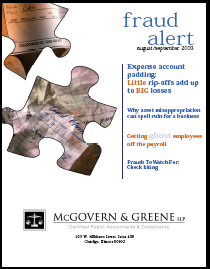 Fraud AlertAUG/SEP 2003 Issue of Fraud Alert
Fraud AlertAUG/SEP 2003 Issue of Fraud Alert
Don’t Let Workers Misuse Expense Accounts
From executives on down, anyone can be tempted to cheat on expense accounts, and expense account policy loopholes let dishonest employees get creative. Companies can encourage honesty by giving staff the benefit of the doubt when possible and by being fairly liberal in per diem rates. But every firm should keep track of who’s claiming what and heed the signs of deceit. This article describes how employees can overstate or fabricate client entertainment, lodging, auto and air travel, and other expenses — then offers tips for how to put a stop to their cheating ways.
You Be the Exorcist
Stopping Ghost Employees and Other Payroll Frauds
Employees who manipulate the company payroll to enrich themselves are downright frightening. And companies that lack defined roles, supervision and internal controls are most at risk for payroll fraud — especially if they use direct deposit and online payroll systems. This article shares warning signs of ghost employees, as well as other payroll frauds such as inflated hours, sales figures and paychecks. It goes on to describe some effective ways to get payroll fraud under control.
Disappearing Act
Why Asset Misappropriation Can Spell Ruin for a Business
The Association of Certified Fraud Examiners’ 2002 Report to the Nation concluded that asset misappropriation is rampant and fraudulent transactions involving cash and checking accounts are by far the most common. This article covers the three most typical cash fraud schemes — skimming, larceny and fraudulent disbursements — with a special emphasis on skimming, the easiest cash fraud for a crooked employee to commit.
Fraud To Watch For:
Check Kiting May Signal More Frauds in Progress
Check kiting happens when an employee, working with at least two accounts at different banks, writes a check for funds not on deposit, deposits the check in another bank, then writes a bigger check on that account and deposits it at the original bank to cover the previous check and reap some extra cash, and so on. Kiting, a serious problem in itself, also can signal other types of fraud the employee may be committing. The article tells how a company can work with its bank and establish internal controls to detect and stop check kiting.
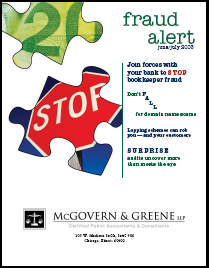 Fraud Alert JUN/JUL 2003 Issue of Fraud Alert
Fraud Alert JUN/JUL 2003 Issue of Fraud Alert
Suspect Bookkeeper Fraud at the Bank?
How To Get the Upper Hand
Small businesses are prime candidates for bookkeeper fraud because their limited staffs make it hard to separate fiscal responsibilities. But just one instance can cost more than $100,000. And that’s only if it’s detected and stopped — some schemes go on for years. What’s the solution? This article discusses how banks can help detect dishonest bookkeepers, and which internal controls at the bank and the company are key to keeping an accounting staff honest.
For a Candid Look at Company Operations, Try a Surprise Audit
A surprise audit is a time-tested technique for detecting and preventing fraud. Adding hard-to-predict elements to the audit process can give an uncensored view of company operations and spotlight any problems. In fact, surprise audits have taken on added importance in today’s climate of strict corporate accountability, with the Association of International Certified Professional Accountants urging auditors to catch companies unaware during regular audits. This article tells how surprises in the audit process can both detect and deter fraud at a company.
Don’t Fall for Domain Name Scams
Persistent Crooks Try Everything To Con Companies
Domain name piracy is an expensive scam that’s becoming more prevalent as increasing numbers of businesses set up their own Web site addresses. Criminals try to con companies into needless domain name renewals or registrations via phone calls, mailings, faxes and e-mails. This article explains some of the most popular methods fraudsters use, and how a company can tell whether it really needs to renew or is just being ripped off.
Fraud To Watch For:
Lapping Steals From Peter To Pay Paul
Dishonest employees steal receivables by “lapping” customer payments — the employee receives a payment and pockets the money instead of applying it to the customer’s account, then steals the next payment to cover up the first. While it’s not the most sophisticated fraud, it can cost a company plenty if allowed to go on. In this article, we explain how to spot and stop lapping.
This publication is distributed with the understanding that the author, publisher and distributor are not rendering legal, accounting or other professional advice or opinions on specific facts or matters, and, accordingly, assume no liability whatsoever in connection with its use.
GFAS Fraud Alert Archives
Expert Forensic Accounting Services
Chicago | Las Vegas
FORENSIC ACCOUNTING
SERVICES
Insurance Claims
Accounting Investigations
Mergers & Acquisitions
Due Diligence Reviews
Dispute Advisory Services
Special Examinations
Contract Audits and Recoveries
LITIGATION SERVICES
Expert Witness Testimony
Commercial Damages
Shareholder/Partner Disputes
Bankruptcy and Insolvency
CPA Malpractice Claims
Contract Disputes
Estate and Trust Disputes
Data Mining & Electronic Discovery
FRAUD EXAMINATIONS

